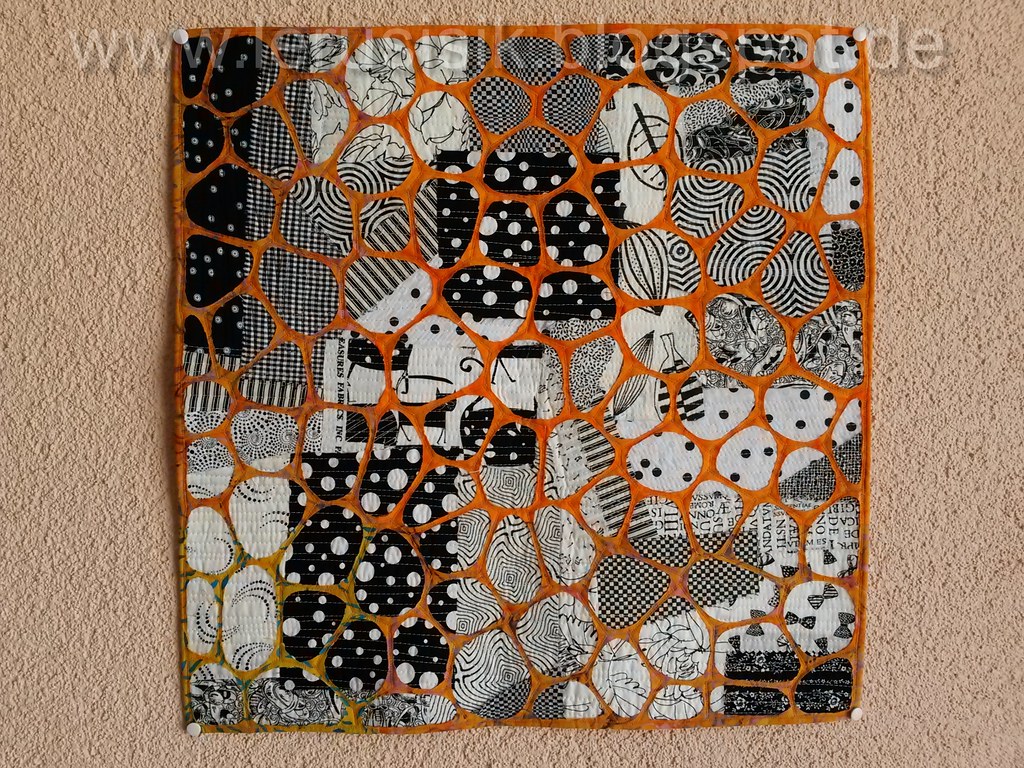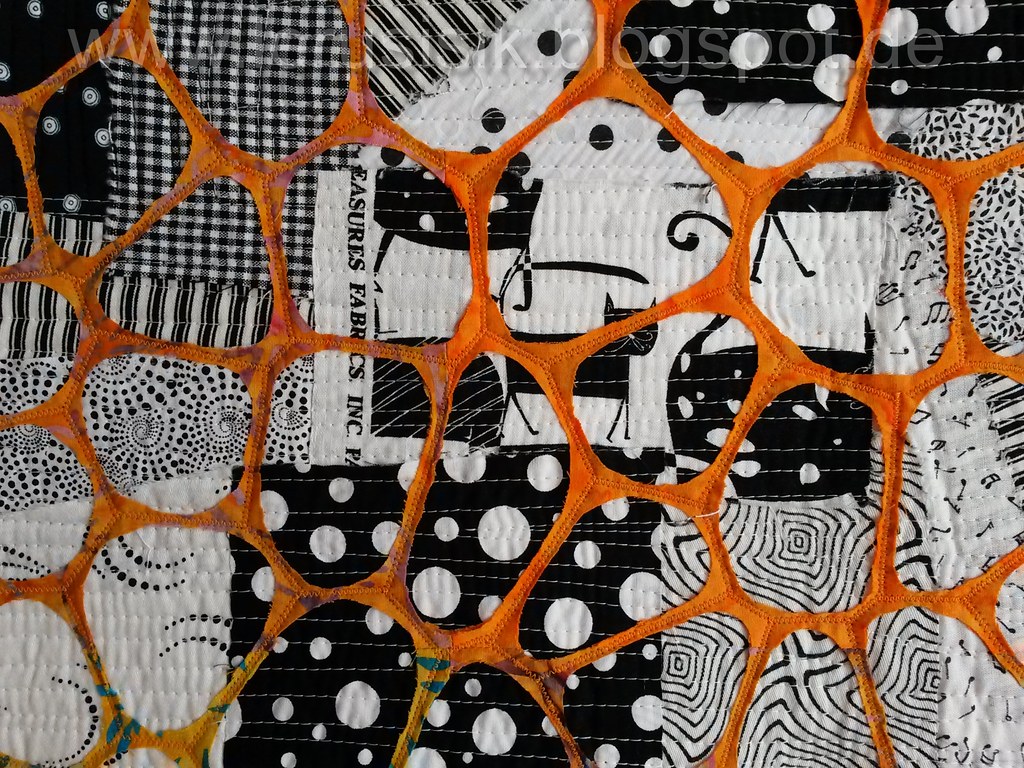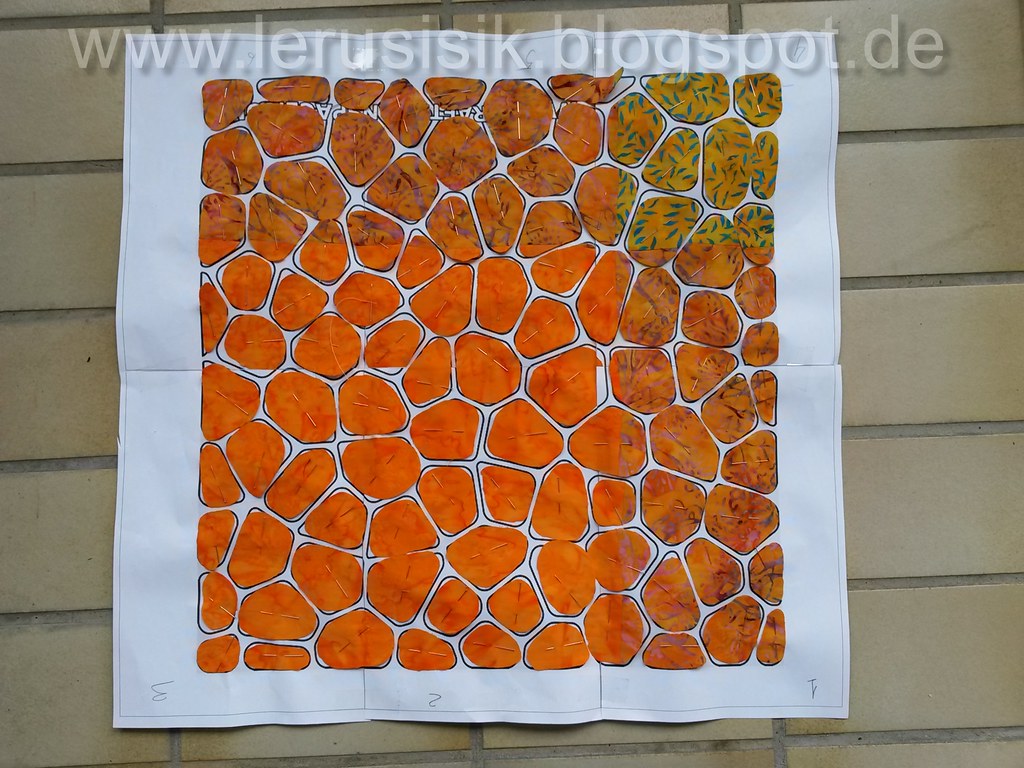I made this quilt for a challenge "Color Brings Diversity to Life". To be exact, I made four quilts for this challenge and this is one of them.
The spots/holes/cells on the quilt are not random, they build a Voronoi diagram. Recently I've discovered this most interesting mathematical object and I'm still in awe about it! I've told about Voronoi diagrams in my previous post with a Voronoi bag (I love that bag!). Shortly: "The Voronoi diagram is a special partitioning of a plane: if there's a given set of points (called generators or seeds) then for each seed there is a corresponding region consisting of all points closer to that seed than to any other. "
The bottom layer is just black and white scraps thrown over the interfacing and densely quilted with rather nonparallel lines. The quilting prevents exposed edges of fabrics from fraying. The black fabric with irregular white polka dots is our challenge fabric.
The top layer is a kind of "whole-cloth raw-edge appliquee" - it's a piece of orange batik fabric, the edges of Voronoi regions were topstitched with narrow zigzag stitch, then the holes were cautiously cut out trying not to damage the bottom layer.
I've kept all cut out orange pieces and pinned them on the pattern sheet for using them later on for another bag or quilt:
I'm very happy to be able to share this quilt as a part of the Blogger's Quilt Festival!
The spots/holes/cells on the quilt are not random, they build a Voronoi diagram. Recently I've discovered this most interesting mathematical object and I'm still in awe about it! I've told about Voronoi diagrams in my previous post with a Voronoi bag (I love that bag!). Shortly: "The Voronoi diagram is a special partitioning of a plane: if there's a given set of points (called generators or seeds) then for each seed there is a corresponding region consisting of all points closer to that seed than to any other. "
The bottom layer is just black and white scraps thrown over the interfacing and densely quilted with rather nonparallel lines. The quilting prevents exposed edges of fabrics from fraying. The black fabric with irregular white polka dots is our challenge fabric.
The top layer is a kind of "whole-cloth raw-edge appliquee" - it's a piece of orange batik fabric, the edges of Voronoi regions were topstitched with narrow zigzag stitch, then the holes were cautiously cut out trying not to damage the bottom layer.
I've kept all cut out orange pieces and pinned them on the pattern sheet for using them later on for another bag or quilt:
I'm very happy to be able to share this quilt as a part of the Blogger's Quilt Festival!




Даже не знаю, что мне больше нравится - оранжевые очертания "пузыриков" или сами оранжевые "пузырики". Очень интересно получилось!
ReplyDeleteI love this quilt and the mathematical aspect of it too!
ReplyDeleteЛерчик,так а где он там?...в трех категориях смотрела...или ты ещё не загрузилась туда..?
ReplyDeleteя его в Original Design заявила. Вроде проверяла, появился.
DeleteО!...не в тех категориях смотрела,ориетировалась на эти твои лейбы...:)Очень интересный квилтик,но подожду ещё русской версии...
DeleteЛер,видела там один квилт заявлен в твоей категории и в моей,а разве можно так,чтобы один и тот же размещать в двух категориях сразу?
Мне давно нравится ента шкурка али камешки.. нравится как ты ее разделала али сконструировала... нравится !
ReplyDeleteThis is amazing! So much delicate work. I love the patterns and the orange colors.
ReplyDelete"orange is the new black" I mean orange is my favorite color of all times!
Delete